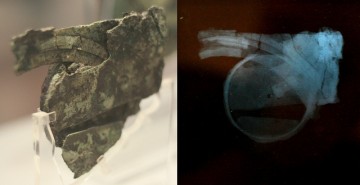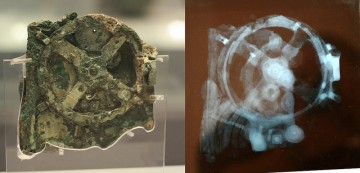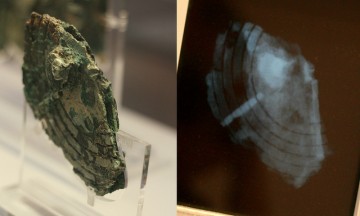Fragment of the Antikythera Mechanism (3)
In October 1900, Greek sponge divers came upon what appeared to be a mass of dead men and horses 60 metres below the waves. Another dive showed these to be bronze statues. These were recovered over many dives until 1902 when archaeologist Valerios Stais spotted a gear wheel embedded in rock. These fragments of gears, dials and pointers were at first thought to be the remains of a mechanical clock. If that wasn't remarkable enough, work by Professor Derek de Solla Price of Yale University in 1974 showed that this was an astronomical computer made around 87 BC.
Fragment of the Antikythera Mechanism
In October 1900, Greek sponge divers came upon what appeared to be a mass of dead men and horses 60 metres below the waves. Another dive showed these to be bronze statues. These were recovered over many dives until 1902 when archaeologist Valerios Stais spotted a gear wheel embedded in rock. These fragments of gears, dials and pointers were at first thought to be the remains of a mechanical clock. If that wasn't remarkable enough, work by Professor Derek de Solla Price of Yale University in 1974 showed that this was an astronomical computer made around 87 BC.
Fragment of the Antikythera Mechanism (2)
In October 1900, Greek sponge divers came upon what appeared to be a mass of dead men and horses 60 metres below the waves. Another dive showed these to be bronze statues. These were recovered over many dives until 1902 when archaeologist Valerios Stais spotted a gear wheel embedded in rock. These fragments of gears, dials and pointers were at first thought to be the remains of a mechanical clock. If that wasn't remarkable enough, work by Professor Derek de Solla Price of Yale University in 1974 showed that this was an astronomical computer made around 87 BC.
Bild: electropod



